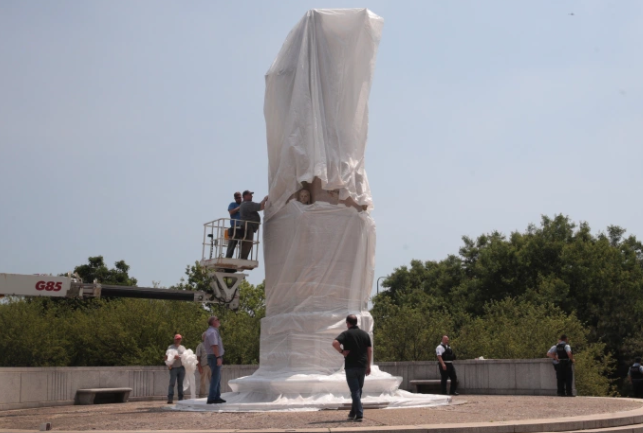Has Christopher Columbus Worn Out His Welcome?
Protests over statues lead city leaders and others to reconsider the controversial discoverer’s importance
Workers covering a statue of Columbus in Chicago, IL on June 19, 2020. This was done before the Juneteenth march, a tribute to June 19, 1865; the date when those who were enslaved became emancipated.
December 11, 2020
The second Monday of every October marks Columbus Day, a day of honor and celebration for some, but also a day symbolizing genocide and exploitation for others. The controversy around the disputed hero is on the rise, and many are questioning their views of the explorer.
Chloe Hild, a junior at East, elaborated on this idea, explaining how “[In elementary school] we were always told that there would be no America without Christopher Columbus. However, as we get older and learn more about European History we realize this statement is definitely not true. Columbus never stepped foot on modern American land.”
According to National Geographic, Columbus first landed on an island referred to as Guanahani by the natives. However, Columbus altered the name to San Salvador, which is now a part of the Bahamas.
After explaining the faults in the material she was taught, Hild highlighted how her opinion of this “hero” has changed. “My opinion on Columbus Day has definitely changed as I got older and learned more about the horrible things he did in regards to treatment of the natives.”
A history.com article elaborates on this, describing how Columbus forced Native Americans to convert to Christianity, enslaved many of them, and he and the rest of Europe brought along a plethora of new diseases that created lasting detrimental effects. To Native Americans, Columbus Day marks a history of genocide and exploitation.
Although some view Columbus in a negative light, it’s important to note that some of our societal values have changed since the late 1400s.
Mr. Currie, a U.S. History teacher at East, elaborated on the importance of the context of the time period, stating that “we need to be conscious that we are looking at an event which occurred 528 years ago with a 21st Century mindset which can skew our views. The world that Christopher Columbus lived in had different values, outlooks, and ideas than what we have today.”
Currie continued to explain the history of Columbus and the exigence behind his discovery: Spain’s hope to find new trade routes and escape overseas threat. “When Columbus was working for Spain, European kingdoms felt a huge threat from the Ottoman Empire and the Turkish empire controlled a large part of Eastern Europe along with the majority of the Mediterranean Sea. The Spanish were literally looking for new trade routes but also new lands to escape the Ottoman threat,” Currie explained.
During a time of strong advocacy for racial equality, the controversy over Columbus has increased. Strong opinions are being formed.
Currie highlighted the importance of shaping a well-informed opinion, one based on a variety of perspectives. “The key to understanding and advocating your ideas and theories about Christopher Columbus, or any subject for that matter, is to develop context and background by reading and questioning various articles and points of view to shape your own opinion.”
Currie thinks that the holiday should still be celebrated, but people should recognize both sides of the story, positive and negative.
The controversy surrounding Columbus and other historical figures has spurred action from Chicago Mayor Lori Lightfoot. Amidst the COVID-19 pandemic and fight for racial justice, Lightfoot has created a committee to review Chicago’s monuments. She has also ordered the removal of multiple Columbus statues, and her administration has claimed they will fund a new series of public artwork aimed to focus on topics such as inequality and racial reconciliation.
Lightfoot elaborated on this in a press release: “This effort is not just about a single statue or mural, but how we create a platform to channel our city’s dynamic civic energy to purposefully reflect our values as Chicagoans and uplift the stories of our city’s residents, particularly when it comes to the permanent memorialization of our history and shared heritage.”
There have also been numerous protests against Columbus nationwide, some resulting in the destruction of Columbus statues. Protestors in Minnesota managed to uproot a Columbus monument using a rope. In Richmond, Virginia, protestors vandalized a Columbus statue before it was removed and thrown into a lake.
In contrast to the strong anti-Columbus views, many Italian-Americans have continued to fiercely defend the Italian-born explorer. New York Governor, Andrew Cuomo stated, “The Christopher Columbus statue represents in some ways the Italian American legacy in this country and the Italian American contribution in this country.” After acknowledging the wrongful actions taken by Columbus, Cuomo added, “The statue has come to represent and signify appreciation for the Italian American contribution to New York. For that reason I support it.”
For states whose beliefs do not align with Cuomo’s perspective, legislation has been passed by state governments to right the wrong that many people view Columbus Day to be. Countless states, including Alaska, Maine, New Mexico, Oregon, and Vermont have made the switch to celebrating Indigenous Peoples’ Day: a celebration of the culture and history of Native Americans.
While some school districts continue to have Columbus Day as a school holiday on their calendars, such as D303, others, like most of those in Wisconsin and some in Illinois, like Naperville CUSD 203, have opted to have it removed as a day off of school.













